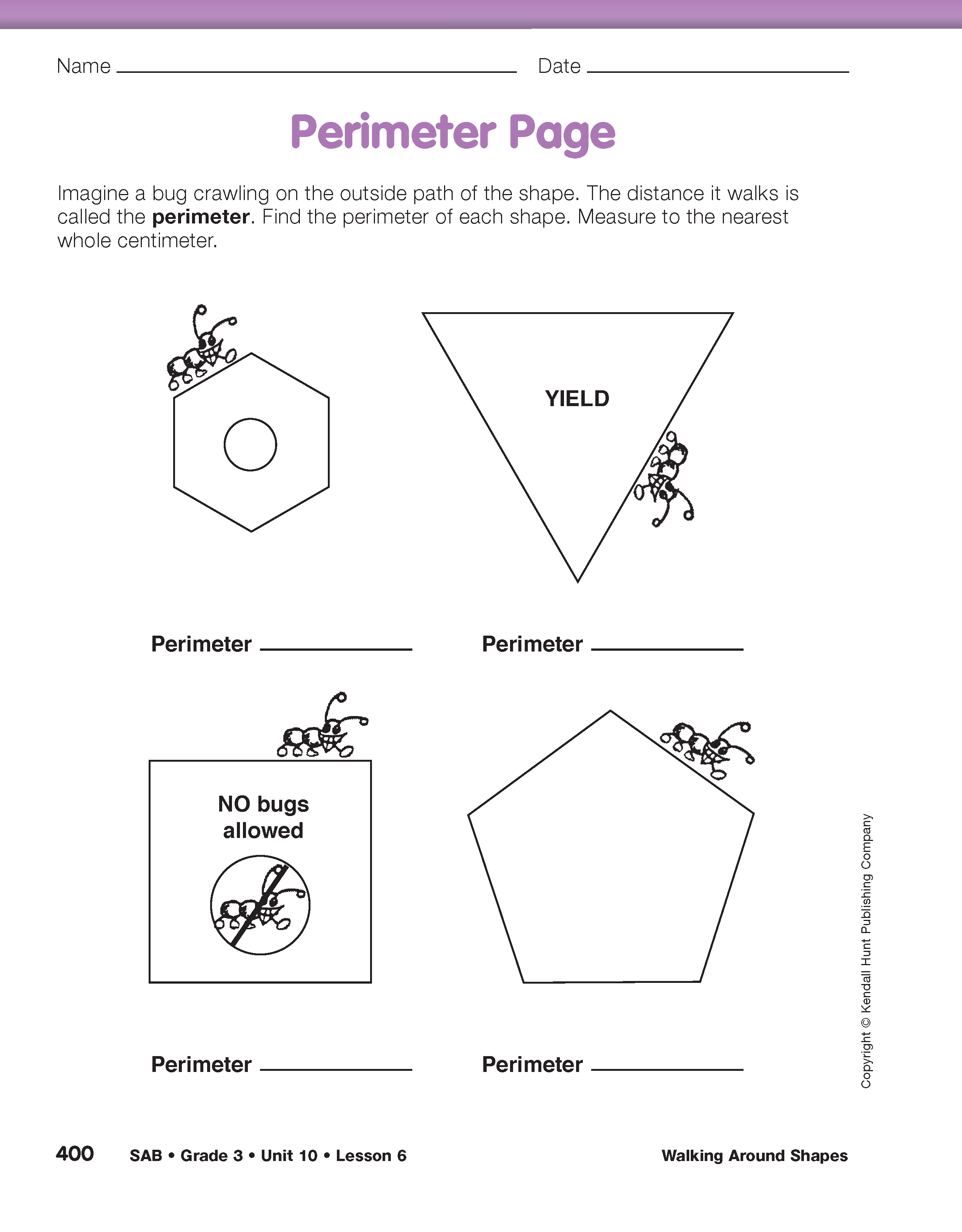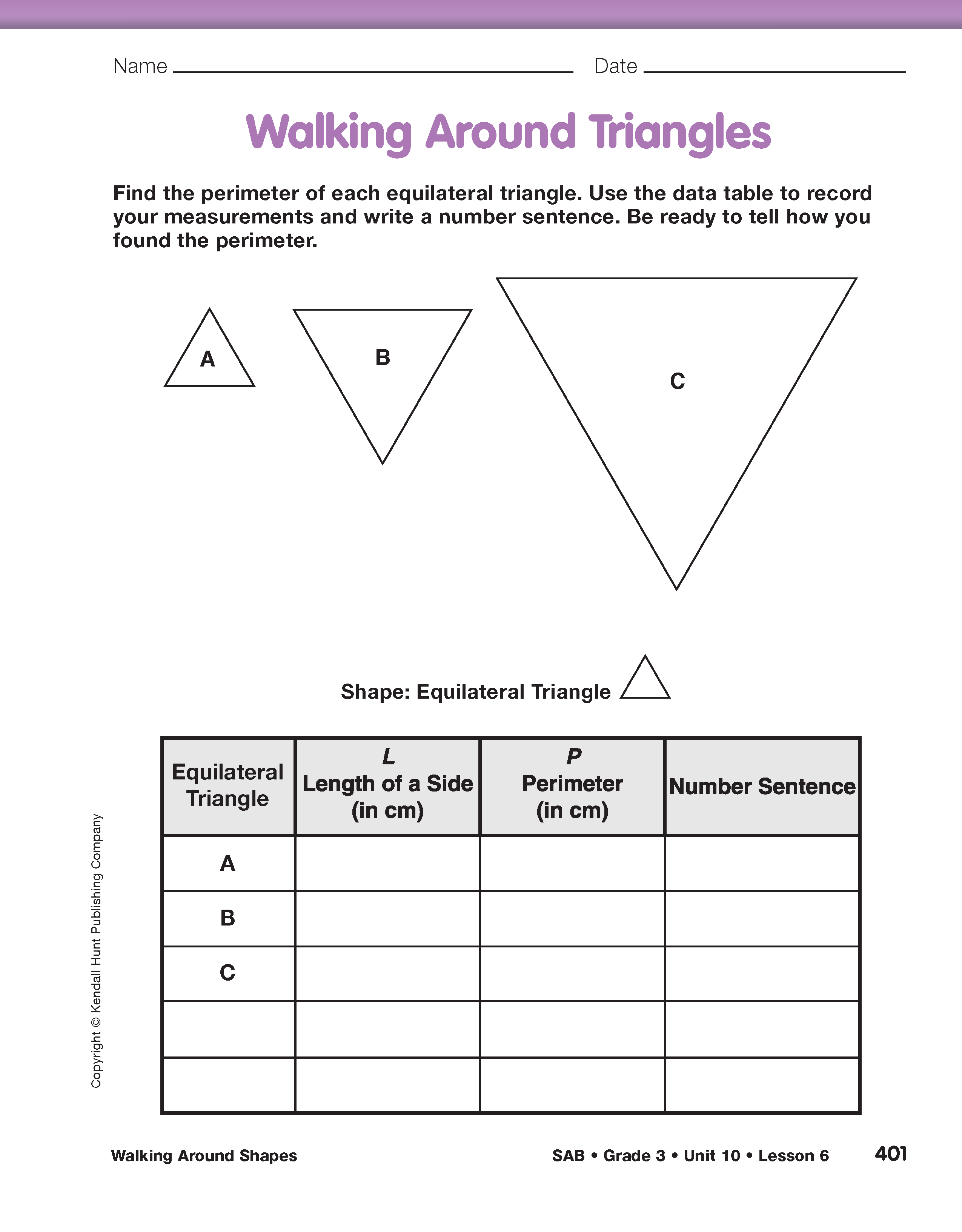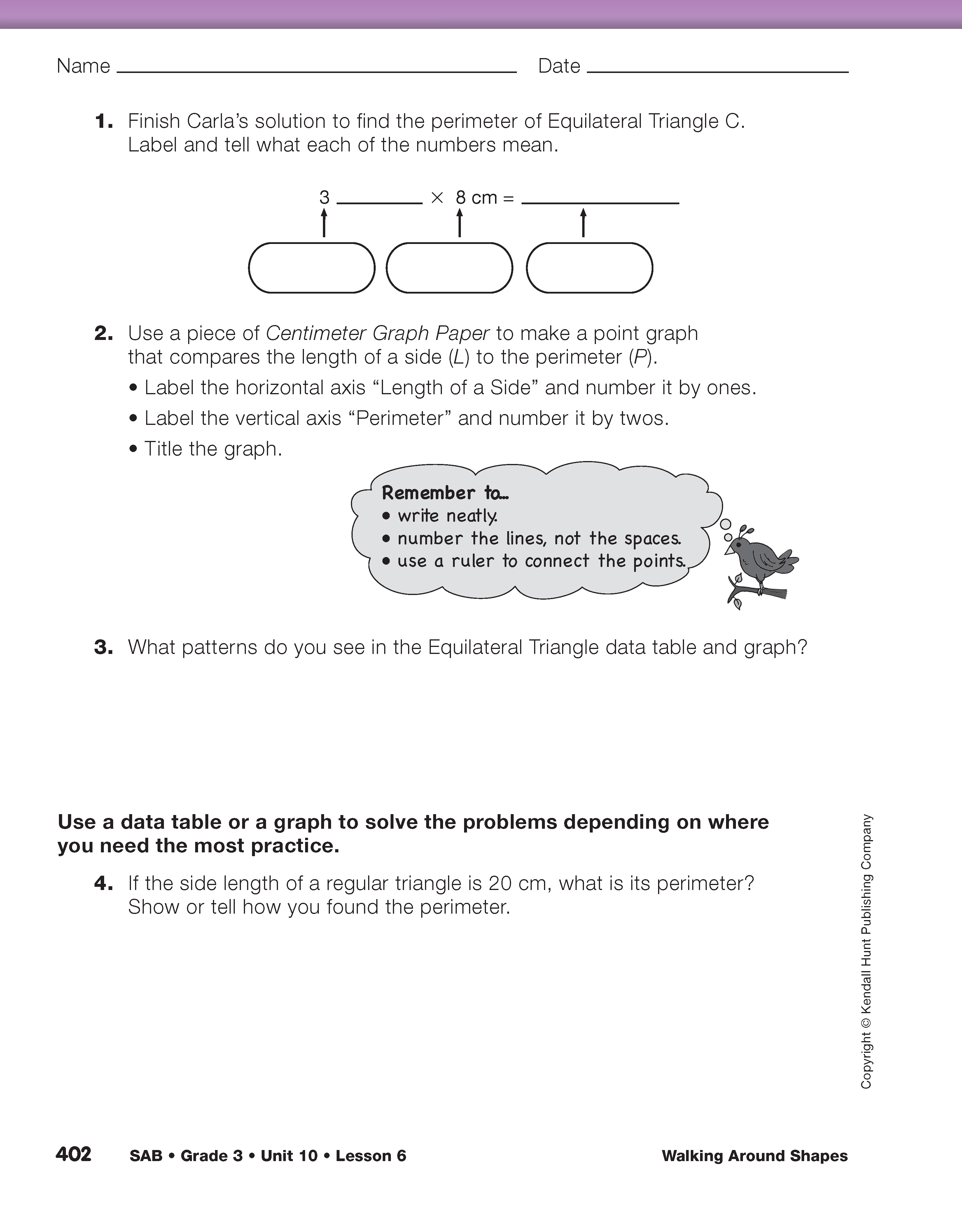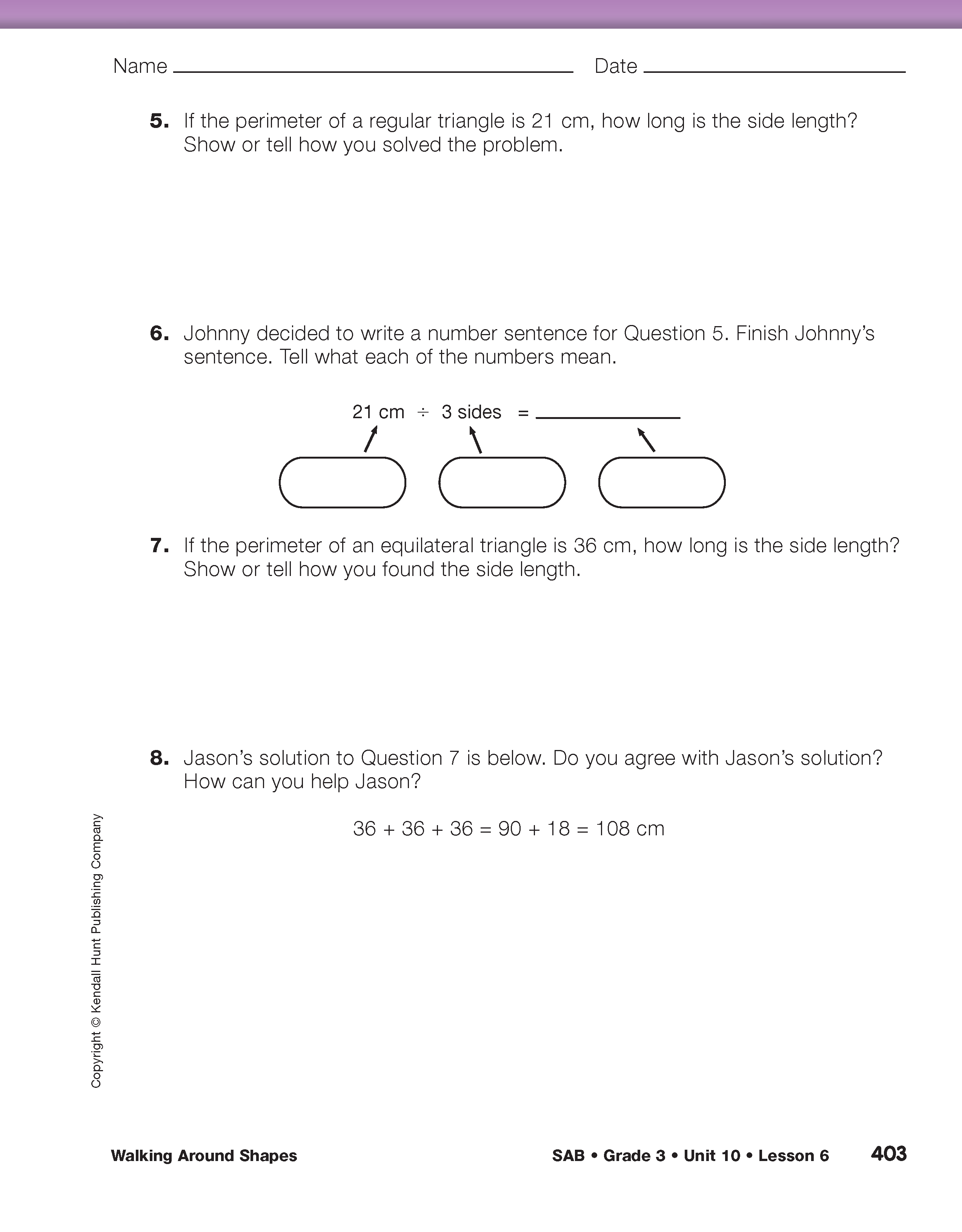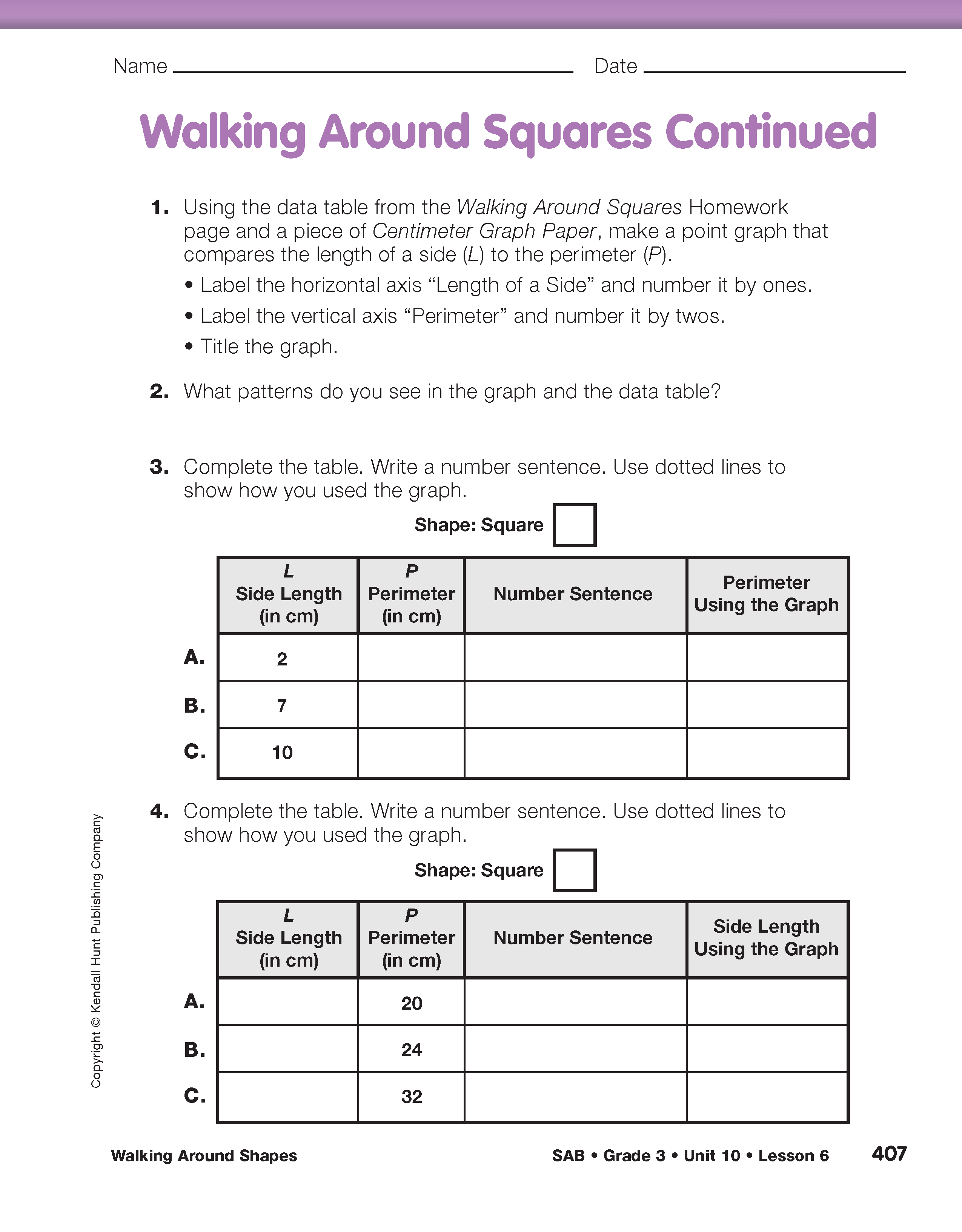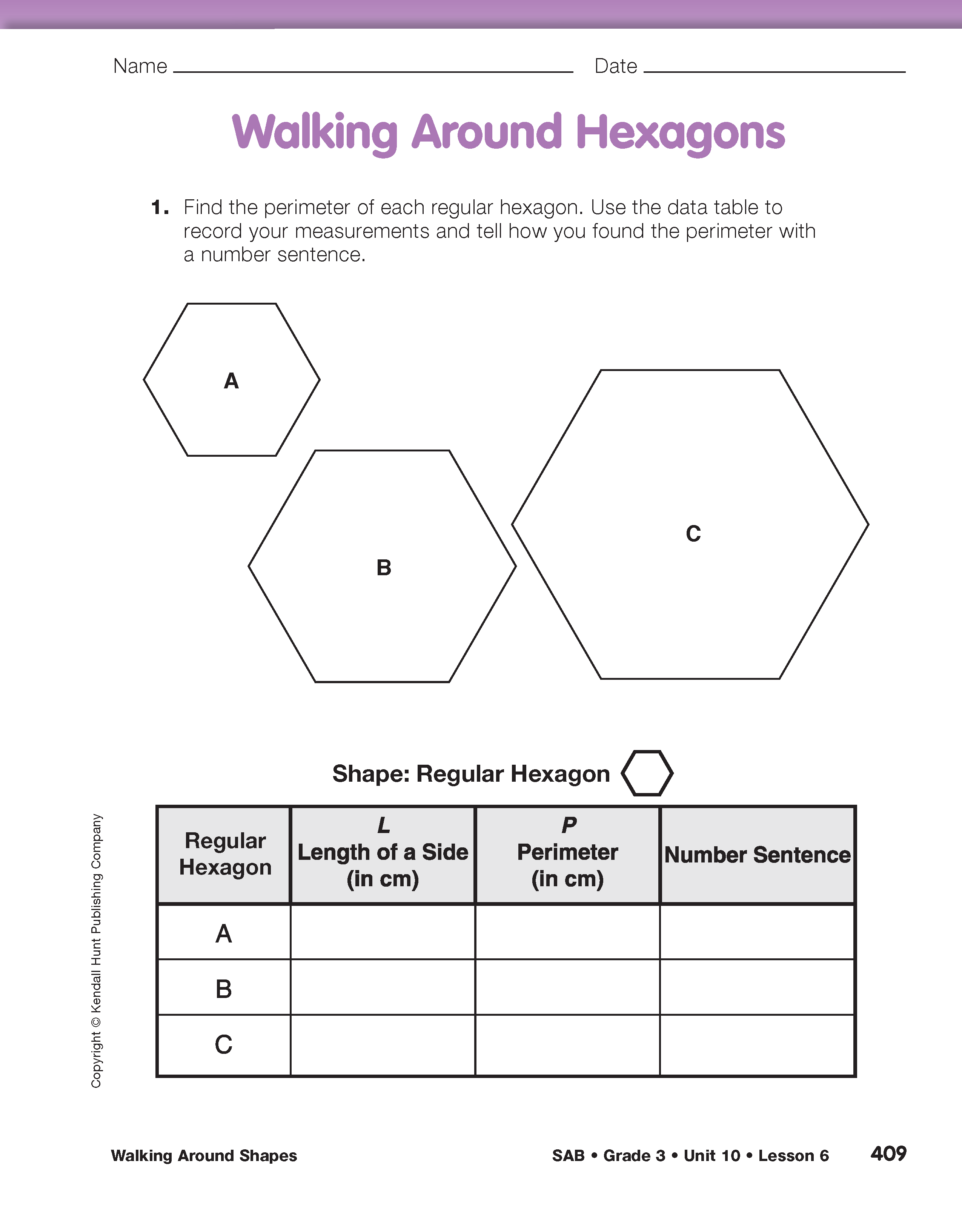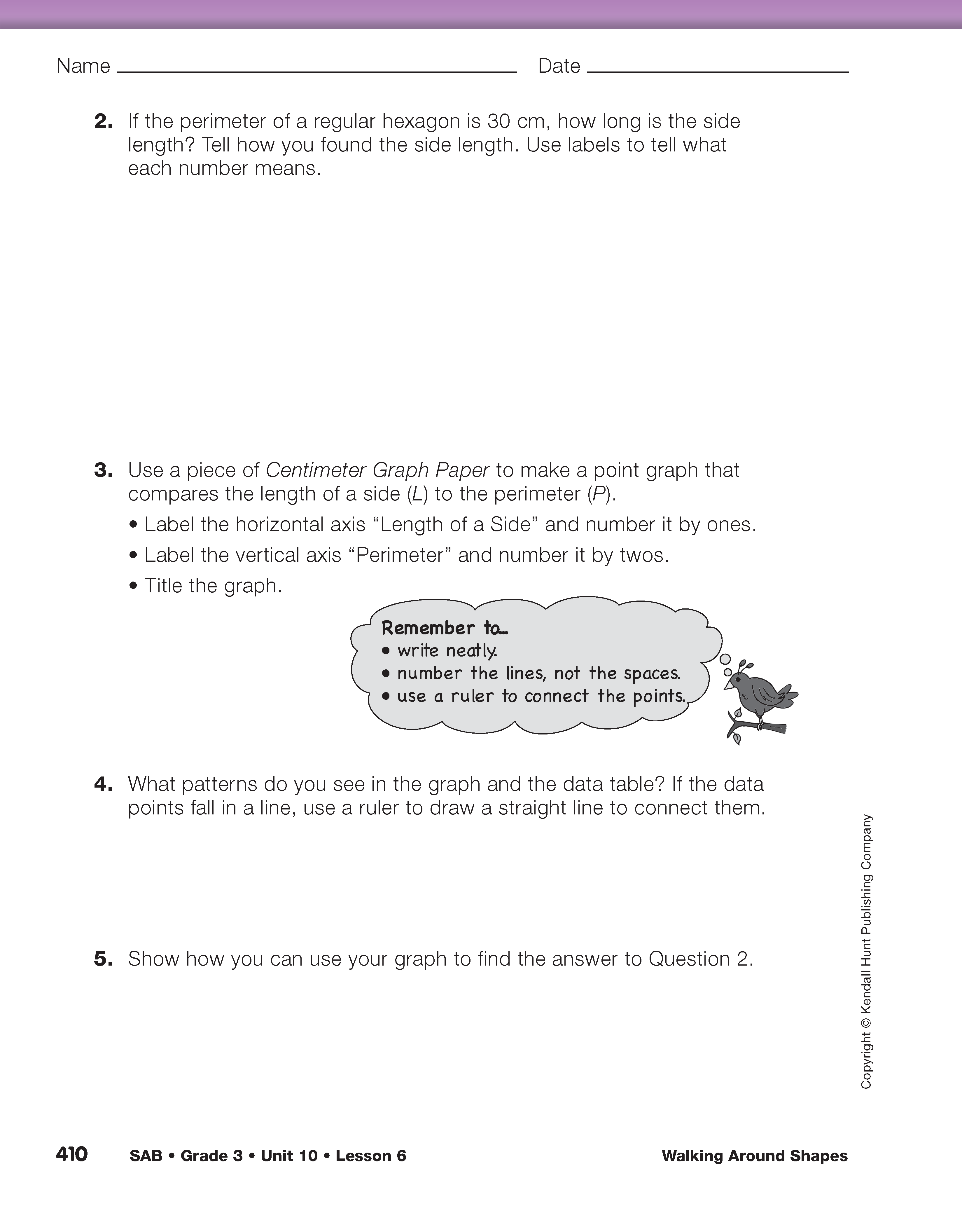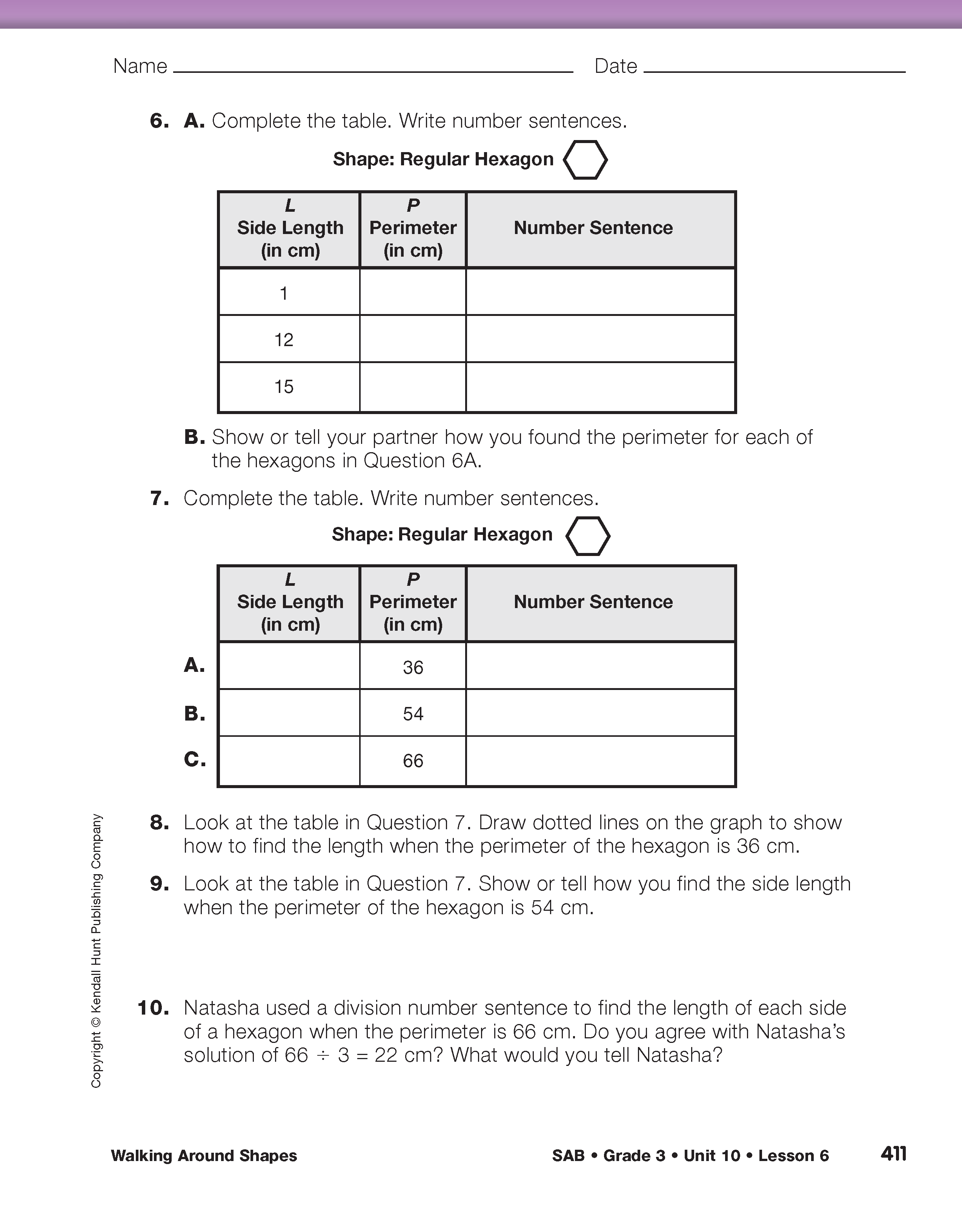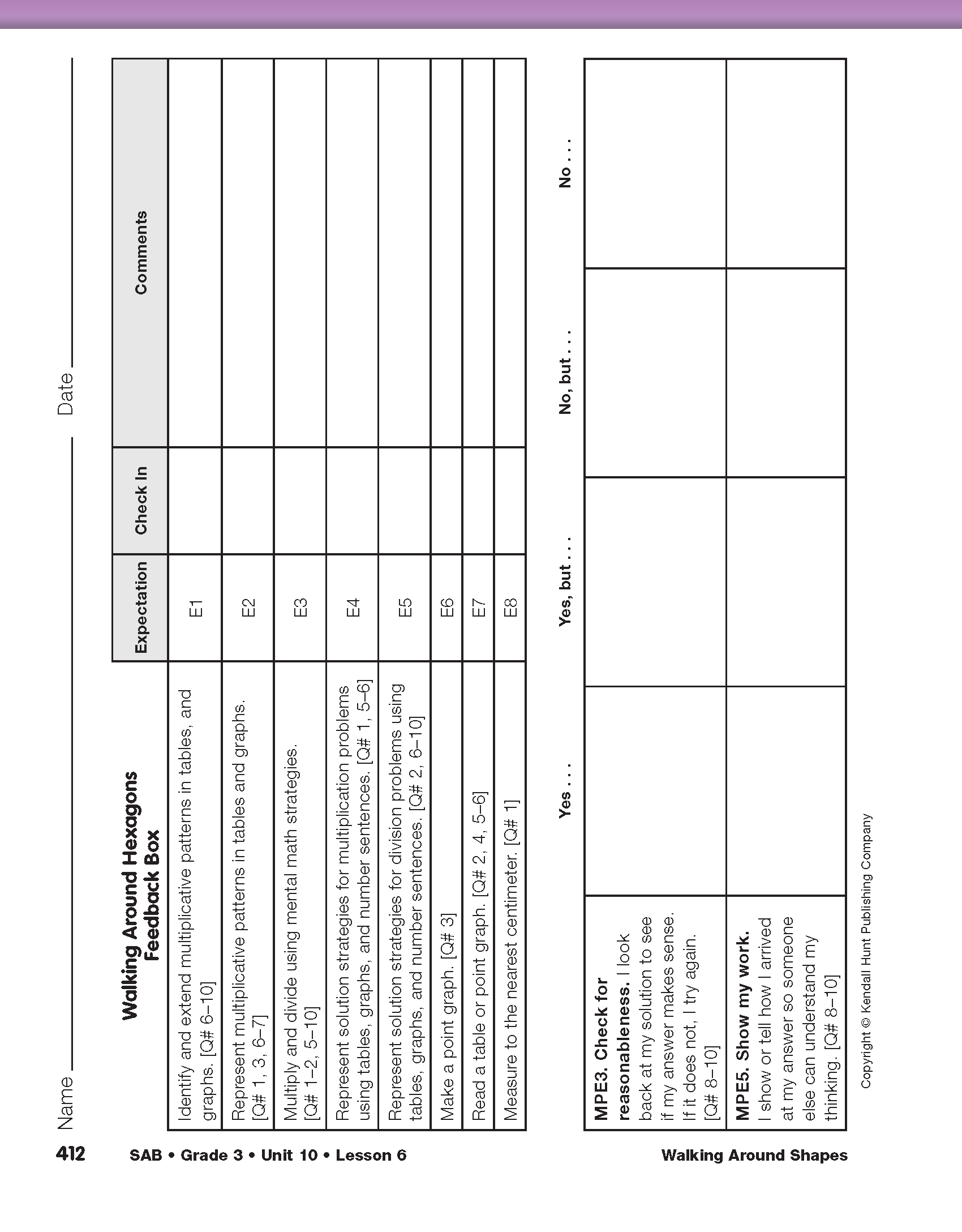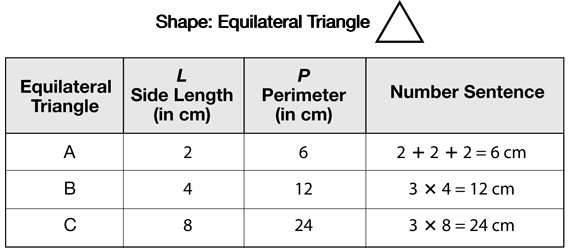Introduce Perimeter. Display and direct students' attention to the Perimeter section of the Walking Around Shapes pages in the Student Guide.
- What is the same about all of these shapes? (They are all regular shapes or the sides of the shapes are all the same length.)
- What is different about all of these shapes? (They have a different number of sides and the side length of each shape is different.)
In this section, students read that a bug is crawling on the outside path of each shape. The distance it walks is the shape's perimeter. Students use their fingers to trace the perimeter of the bug's path for each shape. They will not measure at this point.
- Show me the path the bug will walk. (Have a student trace the outline of the triangle showing where they are going to start and stop.)
- How far is the bug going to walk? How can we figure that out? (Possible response: Measure the length of the path with a ruler.)
Find Perimeter. Have students turn to Perimeter Page in the Student Activity Book. Ask students to use a centimeter ruler to find the perimeter of each of the shapes. Tell them to measure carefully to the nearest whole centimeter. Observe students as they measure.
Observe students as they are working on Perimeter Page from the Student Activity Book to assess their abilities to measure to the nearest whole centimeter [E8]. Some things to watch for:
- Are students using the centimeter side of the ruler?
- Are students starting to measure at zero or another whole number?
- Are students measuring to the nearest whole centimeter?
Once students have had a chance to find the perimeter of the shapes, ask them to share their strategies using discussion prompts similar to the following:
- What did you do to find the perimeter of the hexagon? (Possible response: I measured one side and got 2 cm. I measured and the next side was 2 cm so I added 2 + 2. I kept measuring and adding until I finished all six sides. The perimeter was 12 centimeters.)
- Did anyone find the perimeter a different way? (Possible response: I measured one side and realized that it was a regular hexagon so all the sides were going to be the same length. I used repeated addition, 2 + 2 + 2 + 2 + 2 + 2 = 12 cm.)
- Did anyone find a quicker or more efficient way? (Possible response: I knew it was a regular hexagon so I measured the first side and then did 2 cm × 6 sides = 12 cm.)
- Think about the irregular shapes we studied. How would you find the perimeter of an irregular shape? (Measure each side and add the lengths.)
- Is there a quicker or more efficient way to find the perimeter of an irregular shape? (No, because the sides are not all the same length.)
Walking Around Triangles. Display the triangles on the Collection of Shapes 1 Master and direct students' attention to the Walking Around Triangles pages in the Student Activity Book.
- What would you do to find the perimeter of triangle A? (Possible response: Measure one side and multiply by three or measure one side and add that number three times.)
- What unit are we measuring with? (Possible response: centimeters)
Encourage students to label all the numbers in their solution. For example, 3 sides 3 cm = 9 cm. Ask students to find the perimeters of triangles A, B, and C and record their work in the data table. See Figure 1.
After students have found the perimeters of equilateral triangles A, B, and C, ask them to answer Question 1. This will emphasize the relationship between the side length and the perimeter of equilateral triangles.
Demonstrate making a point graph of the data. Using a display of the Centimeter Graph Paper Master, plot Length of the Side (L) on the horizontal axis and Perimeter (P) on the vertical axis. Scale the horizontal axis by ones and the vertical axis by twos. This will allow sufficient space on the graph for extrapolation. See Figure 2.
Distribute one copy of the Centimeter Graph Paper Master to each student. Assign Questions 2–3. Students will make their own graphs and look for patterns.
- Do the points on your graph form a pattern? (Yes, they fall on a straight line going upward.)
Show students how to use a ruler to draw a line through the points, extending the line in both directions for extrapolation.
- Use the graph to find the perimeter of an equilateral triangle that has a side length of 10 cm. (30 cm)
Ask a student volunteer to model the procedure using dotted lines, as in Figure 2.
- What number sentence would you write? Write this problem and solution in one of the blank rows at the bottom of the data table. (10 cm + 10 cm + 10 cm = 30 cm or 3 sides × 10 cm = 30 cm)
- Look at the multiplication sentence 3 × 10 = 30. What do each of the numbers in this number sentence mean? (The 3 is the number of sides on the shape. The 10 is the length of each side of the shape. The 30 is the perimeter of the shape.)
- What labels should we use? (sides, centimeters)
- Find the perimeter of a regular triangle that has a side length of 3 cm. Record your work in one of the blank rows in the data table. (9 cm; 3 cm + 3 cm + 3 cm = 9 cm or 3 sides × 3 cm = 9 cm)
- Draw dotted lines on the graph to show your solution.
Discuss other methods for finding the perimeter. Explain how a second method can be used to check for reasonableness. Encourage students to use the graph, patterns in the data table, and number sentences to solve the problems.
Assign Questions 4–8 on the Walking Around Triangles pages to student pairs. Encourage students to explore different ways of finding the perimeter and side length using the graph, multiplication, and division.
- If the perimeter of a regular triangle is 21 cm, how long is the side length? (7 cm)
- How did you find the side length? (Possible response: I thought about multiplication. There are 3 sides to the triangle, so 3 × something = 21. I know 3 × 3 = 9, so 6 × 3 = 18. That is close to 21. One more 3 is 18 + 3 = 21. 7 cm × 3 sides = 21 cm perimeter.)
- Show how you use the graph to find the side length. (Find the perimeter of 21 centimeters on the vertical axis, follow dotted lines over to the straight line, and follow dotted lines down to the horizontal axis to find the side length of 3 centimeters.)
Assign the Walking Around Squares Homework page from the Student Activity Book. Students will need the data they find on this homework page to continue the lesson.
Walking Around Squares. Students will need their Walking Around Squares Homework pages. Ask students to share strategies and solutions to Questions 1–2.
Direct students' attention to the Walking Around Squares Continued page in the Student Activity Book. Distribute a copy of the Centimeter Graph Paper Master to each student. Assign Questions 1–2. Using the data table from the Walking Around Squares Homework page and the guidelines given on the page, students will make a point graph for squares like they did for triangles. They look for patterns in both the graph and the data table.
- What patterns do you see in the data table? (Possible response: If I multiply the number in the Length column by 4, I get the number in the Perimeter column.)
- What patterns do you see in the shape of the graph? (The data points fall along a straight line going upward.)
If students do not do so independently, remind them to use their rulers to connect the data points with a straight line. As you discuss the following problems, include a variety of solution strategies including using patterns in the graph, data table, and number sentences. Have a display of the Centimeter Graph Paper Master available for students to use to share their solutions.
- Explain how to use the graph to find the perimeter of a square with a side length of 4 centimeters. (Possible response: Find 4 on the horizontal axis and draw a dotted line up to the straight line connecting the data points. From this point, draw a dotted line over to the vertical axis where it hits 16, the perimeter.)
- Solve the problem another way. (Strategies will vary.)
- Write a number sentence to show what you did. (Possible response: 4 sides × 4 cm = 16 cm or 4 cm + 4 cm + 4 cm + 4 cm = 16 cm)
- Explain how to find the side length of a square with a perimeter of 28 centimeters.
- Solve the problem another way.
- Write a number sentence to show what you did. (Possible response: 28 cm ÷ 4 = 7 cm. Or I used addition, 7 cm + 7 cm + 7 cm + 7 cm = 28 cm.)
Assign Questions 3–4 to student pairs.
Walking Around Hexagons. For the last part of the lesson, distribute a copy of the Centimeter Graph Paper Master to each student. Assign the Walking Around Hexagons pages in the Student Activity Book to student pairs. These pages are similar to the Walking Around Triangles and Walking Around Squares pages. For this assessment, students are asked to find the perimeters of hexagons, make a point graph, and use patterns in the graph and data table to find perimeters and side lengths of other hexagons.

Use Walking Around Hexagons from the Student Activity Book to assess students' progress toward the following Expectations:
- Identify, extend, and represent multiplicative patterns in tables and graphs [E1, E2].
- Multiply and divide using mental math strategies [E3].
- Represent solution strategies for multiplication and division problems using a table, graph, and number sentences [E4] and [E5].
- Make a point graph [E6].
- Read a table or point graph [E7].
- Measure to the nearest whole centimeter [E8].
Use Walking Around Hexagons to assess students' abilities to communicate their solutions using check for reasonableness [MPE3] and show my work [MPE5].
Some of these problems are beyond the limit of the graph. Students should be encouraged to use multiplication or repeated addition to solve these problems. They should also be encouraged to use the graph in creative ways. See the Sample Dialog box.

Use the prompts in this Sample Dialog to discuss strategies to reason from the graph.
Teacher: How can you use a graph to find the perimeter of a hexagon that has a side length of 12 centimeters?
John: We can't. A hexagon with a side length of 12 centimeters is off the graph.
Teacher: Does anyone disagree with John?
Grace: I do not agree. I know that for a side length of 6 cm the perimeter is 36 cm. I read that on the graph. 6 is half of 12 so that is half the perimeter. So 36 cm + 36 cm = 72 cm.
Teacher: Interesting strategy, Grace. Can someone show another way of finding the perimeter if the side length is 12 cm?
Ming: 12 × 6 = 72.
Teacher: How did you figure out 72 cm?
Ming: 10 × 6 = 60 and 6 × 2 = 12, so 60 + 12 = 72.
Teacher: I like how you broke the problem up into smaller problems that you could do in your head.














